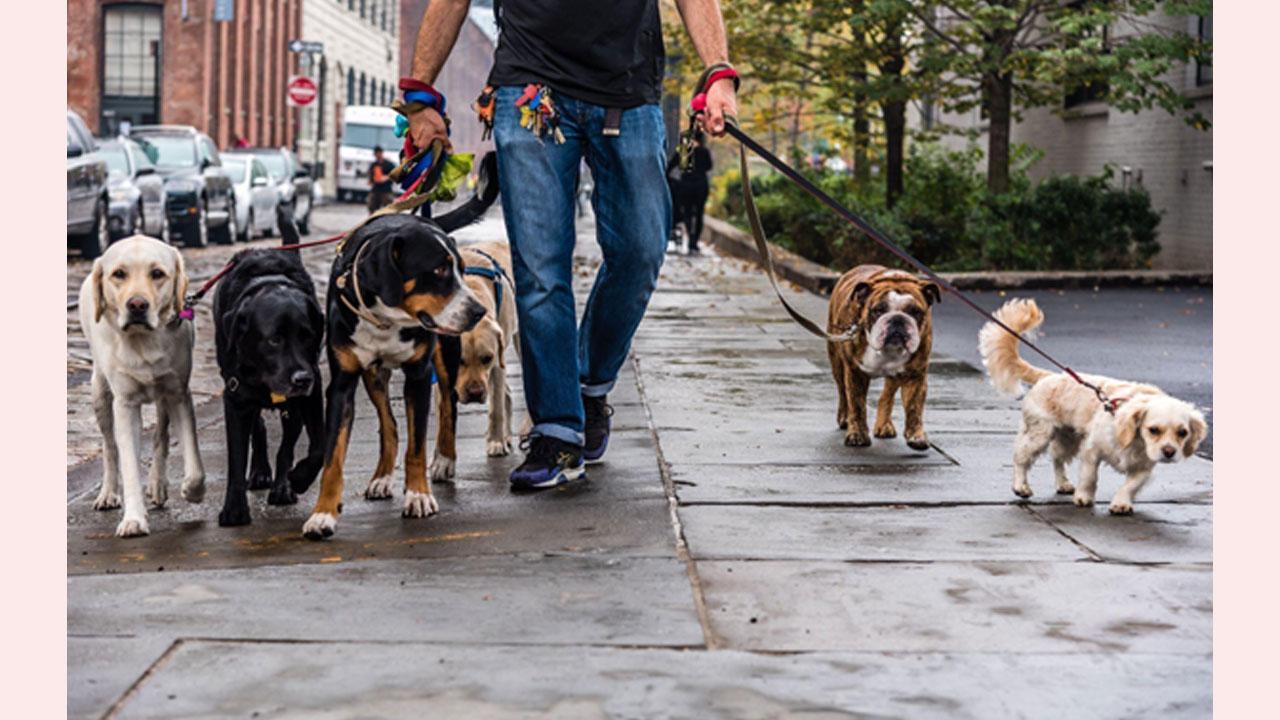Always watch your dog during these activities and remove anything they might knock over or hurt themselves on.

Dog walking
It’s 2025, and many pet parents are still confused about, "How long should I walk my dog?" But trust us, taking your dog for walks shouldn’t be that difficult. Kirti Tripathi, Pet Behavior Expert at Sploot, explains dog walking is much more than bathroom breaks-it’s essential for your pet’s physical health, mental stimulation, and emotional bond with you.
ADVERTISEMENT
To help concerned pet parents find the right answer to their question-how often should you walk your dog-Tripathi offers her professional insights on creating the perfect schedule that works for both you and your dog.
How To Walk Your Dog The Right Way?
Dog walking does not have to be hard. Kirti Tripathi shares some simple tips to keep your dog safe while walking.
- Opt for a harness and a strong leash to keep the dog in control.
- Match your dog’s natural speed so they don’t feel rushed or dragged.
- Teach basic commands to help them behave better during walks.
- Let your dog sniff and explore. It is fun for them and keeps their mind active.
- Avoid routes with traffic, crowds, other animals, or hot pavement.
How Often Should You Walk Your Dog?
"In my practice, I'm frequently asked about optimal walking frequencies," shares Tripathi. "While there's no universal answer, finding out your dog's unique needs is crucial for creating an effective walking routine."
What Affects Your Dog's Walking Needs?
Tripathi adds, "When planning to walk your dog, always consider certain factors such as age, breed, and energy levels."
1. Energy Level and Breed:
- Energetic breeds like Indian Pariah Dogs or German Shepherds typically thrive with 2-3 daily walks. These breeds benefit from longer or more frequent outings that include activities like running or play.
- More relaxed breeds like Shih Tzus or Labradors may be content with 1-2 shorter outings, focusing on sniffing and exploration.
2. Size and Age:
- Smaller breeds, such as Chihuahuas, may thrive on shorter but more frequent walks due to their smaller strides and energy bursts. Puppies also require shorter walks spaced throughout the day to avoid overexertion and harm of developing bones and joints diseases such as arthritis.
- Senior dogs, regardless of size, usually prefer slow-paced strolls depending on their stamina. These walks should prioritize comfort and avoid any rigorous activities that could strain their aging bodies.
3. Medical History:
- Arthritis, obesity, or respiratory issues may lead to changes in the walking routine. For example, softer terrain and shorter walks can minimize discomfort for arthritic dogs. In cases of chronic health issues, always consult your veterinarian to design a safe and effective exercise plan.
Signs like too much energy, weight gain, or limping may signal a change in your dog’s walking schedule. If you’re unsure, ask an expert or try professional dog walking services to make sure your pet gets enough exercise.
Walk Types and Their Benefits
Different types of walks serve various purposes for your dog's well-being:
|
Type of Walk |
Purpose |
Exercise Level |
Benefits |
|
Potty Walks |
Basic needs |
Low |
Establishes regular bathroom routine |
|
Socialization Walks |
Meeting others |
Medium |
Develops social confidence |
|
Training Walks
|
Learning |
Medium |
Improves obedience and focus |
|
Hiking |
Adventure |
High |
Builds physical strength |
|
Leisure Strolls |
Relaxation |
Low |
Reduces anxiety and stress |
Which breeds need walks more often?
“Different dog breeds have unique exercise needs based on their purpose," Tripathi explains. That’s where professional dog walking services come into the picture. They can make sure your pet gets the right amount of exercise.
|
Dog Breeds That May Need 2-3 Hours Of Daily Activity, Often Split Into Multiple Walks |
Dog Breeds That May Generally Need 30-60 Minutes Of Exercise Daily
|
|
● Indian Pariah Dogs ● German Shepherds ● Siberian Huskies ● Belgian Malinois ● Dalmatians ● Labrador Retrievers ● Golden Retrievers ● Beagles ● Boxers ● German Shorthaired Pointers ● Cocker Spaniels |
● Bulldogs ● Shih Tzus ● Pugs ● Chihuahuas ● Basset Hounds ● Great Danes |
For all the breeds, daily walks that meet your dog's specific needs are vital for their overall health and happiness.
When You Can't Walk Your Dog
When walking your dog isn't possible, try these engaging indoor activities:
- Indoor Obstacle Course: Create a playfield right at home using items you already own. Try making tunnels with blankets stretched over chairs, setting up pillow paths. If your dog enjoys it, you might want to invest in some portable agility equipment.
- Indoor Leash Training: Use your home as the first training ground for leash skills. Walk through hallways while teaching "heel," and practice navigating corners and doorways. Training indoors where there are fewer distractions make the training process easier.
- Puzzle Toys: Keep your dog's mind busy with toys that hide treats or make them solve simple problems to get rewards. Start with easy toys that drop treats when pushed around, then move to harder puzzles as your dog gets better at solving them. Switch between different toys to keep things interesting.
- Indoor Agility: Create simple exercise stations in your home. Teach your dog to walk on stable boards placed low to the ground, practice staying in place until called, or work on movements like backing up. These activities help keep your dog fit and confident.
- Hide and Seek: Hide toys or treats around your home and let your dog find them. You can even hide yourself and call your dog to find you – this makes training fun while giving them exercise.
- Stair Exercise: If you have stairs, use them for exercise sessions. Walk up and down with your dog at a steady pace. This is great exercise for their legs and heart, but be careful not to overdo it.
Always watch your dog during these activities and remove anything they might knock over or hurt themselves on. While these indoor games are great, they work best when combined with regular walks whenever possible.
What Is The Best Time For Walking Your Dog?
"Timing plays a key role in maintaining a successful walking routine," Tripathi explains. In summer, choose early mornings or evenings for walks to avoid heat and stay safe. In winter, midday walks are often more comfortable due to the warmer temperatures. Waiting at least an hour after meals before walking your dog helps prevent any digestive problems. Be mindful of weather conditions and adjust your walking schedule accordingly to keep yourself and your pet comfortable. Staying consistent with your routine will also help build a healthy habit over time.
When to Modify Your Walking Schedule?
Sometimes, adjusting your walking routine becomes necessary. "Pay attention to signs of fatigue like excessive panting or reluctance to move," advises Tripathi. "It’s okay to skip walks and choose indoor activities instead during the winter season. Your pet’s safety and well-being should always come first, even if it means changing their routine once in a while. Alternatives like interactive toys or indoor games can help keep them mentally and physically engaged.
Watch for these warning signs that indicate a need to adjust your walking schedule:
- Excessive tiredness after walks
- Limping or showing signs of discomfort
- Respiratory distress
- Unusual resistance to walking
Making the Most of Your Dog's Walking Routine
Having an effective walking schedule is not just about getting the frequency right – it's about quality time with your pet. "Regular walks strengthen your bond while providing essential exercise," notes Tripathi. For busy pet parents, reliable dog walking services can help maintain consistency when needed.
Remember that your dog's exercise needs will evolve throughout their life. Stay attentive to their signals, consult with professionals when needed, and adjust your walking routine accordingly. "The secret lies in finding a balance that works for both you and your dog," concludes Tripathi. "Whether you opt for multiple short walks or fewer longer sessions, consistency and attention to your dog's individual needs will lead to the best results."
 Subscribe today by clicking the link and stay updated with the latest news!" Click here!
Subscribe today by clicking the link and stay updated with the latest news!" Click here!








